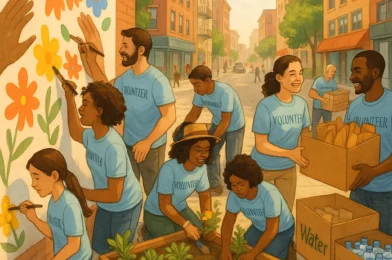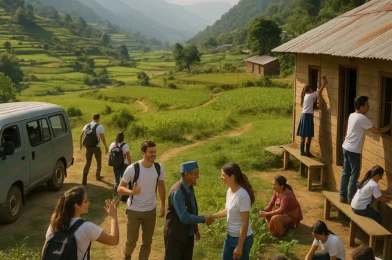You feel the pull of a great city. It’s the electric hum of a million lives lived in unison, the symphony of traffic and languages, the endless maze of streets promising discovery at every turn. You love the energy, the culture, the art, and the feeling of being at the center of it all. But you’re looking for more than a typical tourist experience. You want to see beyond the landmarks and connect with the true heart of the city—its people.
What if you could trade a few hours of sightseeing for an afternoon of service? What if you could understand a city not just by its museums and monuments, but by its soup kitchens and community centers? This is the core of an urban volunteer adventure. It’s a chance to peel back the polished surface of a metropolis and engage with its real-life challenges and triumphs.
Volunteering in a big city allows you to serve on the front lines of the world’s most pressing social issues, from homelessness and food insecurity to refugee integration and youth empowerment. This guide will explore why urban volunteering is so uniquely impactful and highlight five diverse global cities where you can exchange a standard vacation for a truly purposeful journey.
Why Volunteer in a City? The Unique Impact of Urban Service
While volunteering in a remote village or a pristine natural park has its own appeal, choosing to serve in a bustling urban environment offers a distinct and powerful set of experiences.
- Engaging with a Global Crossroads: Cities are melting pots. They are where cultures, ideas, conflicts, and dreams from all over the world converge. When you volunteer in a city, you aren’t just serving one community; you are engaging with global issues like migration, economic inequality, and social justice, all within a few square miles.
- Serving on the Front Lines: Urban centers are often where social needs are most concentrated and visible. This is where you’ll find established, experienced organizations that have been working for years to address these challenges. As a volunteer, you have the opportunity to plug into this existing infrastructure and provide meaningful support to programs that are making a real, measurable difference.
- The Unbeatable Blend of Service and Culture: Urban volunteering offers a unique duality. You can spend your day making a tangible impact—serving meals in a shelter, tutoring a refugee child, or helping to build a community garden. Then, in your free time, you can immerse yourself in world-class culture by exploring iconic museums, listening to live music, and enjoying incredible food. It’s a powerful combination of gritty, hands-on service and enriching cultural exploration.
Five Cities Calling for Your Helping Hands
Every city has its own unique personality, its own challenges, and its own opportunities to serve. Here are five incredible urban centers where you can make a real impact.
1. Lisbon, Portugal: Where Historic Charm Meets Modern Compassion
With its sun-bleached terracotta roofs, historic rattling trams, and soulful Fado music, Lisbon is one of Europe’s most captivating cities. But beneath its charming exterior, this coastal capital is also on the front lines of Europe’s refugee crisis and struggles with issues of homelessness and food insecurity.
- The Urban Landscape: A vibrant, hilly city where historic neighborhoods blend with a trendy, creative arts scene.
- The Heart of the Need: Organizations across Lisbon are working tirelessly to support newly arrived refugees from Africa and the Middle East, as well as providing for a growing population of people experiencing homelessness.
- Your Volunteer Role: You can find meaningful work serving meals at local soup kitchens, sorting donations at food banks, or assisting at welcome centers for refugees by providing childcare, helping with language practice, or simply offering a friendly and welcoming presence.
- After Hours: Get lost in the winding, cobblestone streets of the Alfama district, listen to haunting Fado music in a tiny tavern, and indulge in a world-famous pastéis de nata (or two).
2. Cape Town, South Africa: Confronting the Past, Building the Future
Cape Town is a city of breathtaking, almost impossible beauty, nestled between the iconic Table Mountain and the turquoise Atlantic Ocean. It is also a city of stark contrasts and deep social inequalities, a living legacy of the Apartheid era.
- The Urban Landscape: A stunningly beautiful city with a complex and challenging social fabric.
- The Heart of the Need: The greatest needs are often found in the surrounding townships, where community-led organizations are working to overcome decades of systemic inequality by investing in the next generation.
- Your Volunteer Role: This is an incredible place to focus on youth development. You could find yourself coaching a sports team, assisting with after-school tutoring and homework clubs, teaching art or music classes, or helping to maintain a community garden that provides fresh produce for local families.
- After Hours: Take the cable car to the top of Table Mountain for unforgettable views, visit the sobering Robben Island museum where Nelson Mandela was imprisoned, and explore the vibrant culture and cuisine at the V&A Waterfront.
3. Bangkok, Thailand: Finding Purpose in the Urban Hustle
Bangkok is a sprawling, high-energy megacity—a whirlwind of chaotic traffic, ornate temples, and world-class street food. It is the vibrant heart of Thailand, but this rapid development has also left many vulnerable populations behind.
- The Urban Landscape: A massive, bustling, and humid metropolis where ancient tradition and modern chaos collide.
- The Heart of the Need: Many volunteer opportunities center on supporting at-risk children and migrant communities who often lack access to formal education and social services.
- Your Volunteer Role: You can make a real difference by teaching conversational English in underserved communities, providing childcare and support at daycare centers for the children of migrant workers, or assisting organizations that work with people experiencing homelessness.
- After Hours: Explore the magnificent Grand Palace and Wat Pho (Temple of the Reclining Buddha), navigate the bustling canals in a long-tail boat, and dive into the incredible street food scene.
4. New Orleans, USA: Rebuilding with Rhythm and Soul
A truly unique American city, New Orleans pulses with a rhythm all its own, fueled by jazz music, Creole culture, and an unbreakable spirit. Decades after the devastation of Hurricane Katrina, the city is vibrant but still faces ongoing challenges related to environmental sustainability and community rebuilding.
- The Urban Landscape: A city with a deep soul, incredible music, and a resilient community spirit.
- The Heart of the Need: The needs are diverse, ranging from environmental restoration to supporting the city’s unique cultural heritage.
- Your Volunteer Role: You can get your hands dirty with projects focused on rebuilding homes that are still damaged, restoring coastal wetlands in the surrounding bayous to protect the city from future storms, or supporting youth arts and music programs that are keeping the city’s unique cultural flame alive.
- After Hours: Catch live jazz on Frenchmen Street, explore the historic architecture of the French Quarter, and indulge in beignets at Café du Monde.
5. Athens, Greece: Offering Welcome at a Historic Crossroads
Athens is the cradle of Western civilization, a city where ancient history is visible on every corner. Today, it is also a modern-day crossroads, serving as a primary entry point into Europe for thousands of refugees and migrants seeking safety and a new life.
- The Urban Landscape: An ancient city grappling with very modern humanitarian challenges.
- The Heart of the Need: The need to support displaced populations is immense. Local and international organizations are stretched thin providing for the basic needs of thousands of families.
- Your Volunteer Role: Your help is desperately needed. You can work in refugee community centers, help distribute food and clothing, assist with sorting aid donations in warehouses, provide informal childcare so parents can attend appointments, or simply offer friendship and solidarity to people who have lost everything.
- After Hours: Walk in the footsteps of philosophers at the ancient Acropolis and Parthenon, explore the charming Plaka district, and enjoy fresh Mediterranean food at a local taverna.
Navigating the Concrete Jungle: Tips for Urban Volunteers
- Stay Street Smart: Be aware of your surroundings, especially at night. Keep your valuables secure and listen to the safety advice provided by your host organization.
- Master Public Transportation: Using the city’s subway, bus, or tram system is the most affordable and authentic way to explore. It will help you understand the city’s layout and daily rhythm.
- Practice Cultural Humility: Even in a city that seems familiar, different neighborhoods have their own distinct cultures and social norms. Be a respectful observer. Listen more than you speak.
- Prepare for Emotional Intensity: Working directly with issues like deep poverty, trauma, and social injustice can be emotionally heavy. Make time for self-care and be sure to debrief with your teammates or program leader.
Choosing to volunteer in a big city is a choice to engage with the world in all its beauty and brokenness. It’s an opportunity to look past the tourist attractions and see the real, beating heart of a place. You will leave not just with photos, but with a deeper understanding of our shared humanity and your own capacity to make a difference.
Which of these cities inspires you to serve? Or have you volunteered in an urban setting before? Share your favorite city and why in the comments below!



